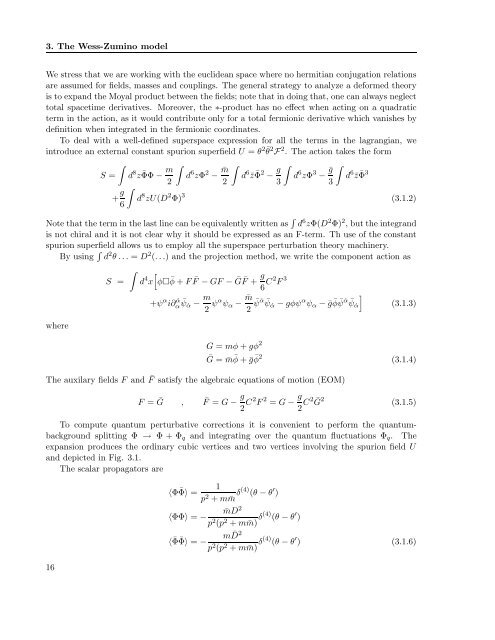Perturbative and non-perturbative infrared behavior of ...
Perturbative and non-perturbative infrared behavior of ...
Perturbative and non-perturbative infrared behavior of ...
You also want an ePaper? Increase the reach of your titles
YUMPU automatically turns print PDFs into web optimized ePapers that Google loves.
3. The Wess-Zumino model<br />
We stress that we are working with the euclidean space where no hermitian conjugation relations<br />
are assumed for fields, masses <strong>and</strong> couplings. The general strategy to analyze a deformed theory<br />
is to exp<strong>and</strong> the Moyal product between the fields; note that in doing that, one can always neglect<br />
total spacetime derivatives. Moreover, the ∗-product has no effect when acting on a quadratic<br />
term in the action, as it would contribute only for a total fermionic derivative which vanishes by<br />
definition when integrated in the fermionic coordinates.<br />
To deal with a well-defined superspace expression for all the terms in the lagrangian, we<br />
introduce an external constant spurion superfield U = θ2¯ θ2F 2 . The action takes the form<br />
<br />
S = d 8 z¯ ΦΦ − m<br />
<br />
2<br />
+ g<br />
<br />
6<br />
d 8 zU(D 2 Φ) 3<br />
d 6 zΦ 2 − ¯m<br />
2<br />
<br />
d 6 ¯z ¯ Φ 2 − g<br />
3<br />
<br />
d 6 zΦ 3 − ¯g<br />
3<br />
<br />
d 6 ¯z ¯ Φ 3<br />
(3.1.2)<br />
Note that the term in the last line can be equivalently written as d 6 zΦ(D 2 Φ) 2 , but the integr<strong>and</strong><br />
is not chiral <strong>and</strong> it is not clear why it should be expressed as an F-term. Th use <strong>of</strong> the constant<br />
spurion superfield allows us to employ all the superspace perturbation theory machinery.<br />
By using d 2 θ ... = D 2 (...) <strong>and</strong> the projection method, we write the component action as<br />
where<br />
S =<br />
<br />
d 4 <br />
x φ¯ φ + F ¯ F − GF − ¯ G ¯ F + g<br />
6 C2F 3<br />
+ψ α i∂ ˙α α ¯ ψ ˙α − m<br />
2 ψα ψα − ¯m<br />
2 ¯ ψ ˙α ¯ ψ ˙α − gφψ α ψα − ¯g ¯ φ ¯ ψ ˙α ¯ ψ ˙α<br />
G = mφ + gφ 2<br />
¯G = ¯m ¯ φ + ¯g ¯ φ 2<br />
The auxilary fields F <strong>and</strong> ¯ F satisfy the algebraic equations <strong>of</strong> motion (EOM)<br />
F = ¯ G , ¯ F = G − g<br />
2 C2 F 2 = G − g<br />
2 C2 ¯ G 2<br />
<br />
(3.1.3)<br />
(3.1.4)<br />
(3.1.5)<br />
To compute quantum <strong>perturbative</strong> corrections it is convenient to perform the quantumbackground<br />
splitting Φ → Φ + Φq <strong>and</strong> integrating over the quantum fluctuations Φq. The<br />
expansion produces the ordinary cubic vertices <strong>and</strong> two vertices involving the spurion field U<br />
<strong>and</strong> depicted in Fig. 3.1.<br />
The scalar propagators are<br />
16<br />
〈Φ ¯ Φ〉 =<br />
〈ΦΦ〉 = −<br />
〈 ¯ Φ ¯ Φ〉 = −<br />
1<br />
p 2 + m ¯m δ(4) (θ − θ ′ )<br />
¯mD 2<br />
p 2 (p 2 + m ¯m) δ(4) (θ − θ ′ )<br />
m ¯ D 2<br />
p 2 (p 2 + m ¯m) δ(4) (θ − θ ′ ) (3.1.6)
















